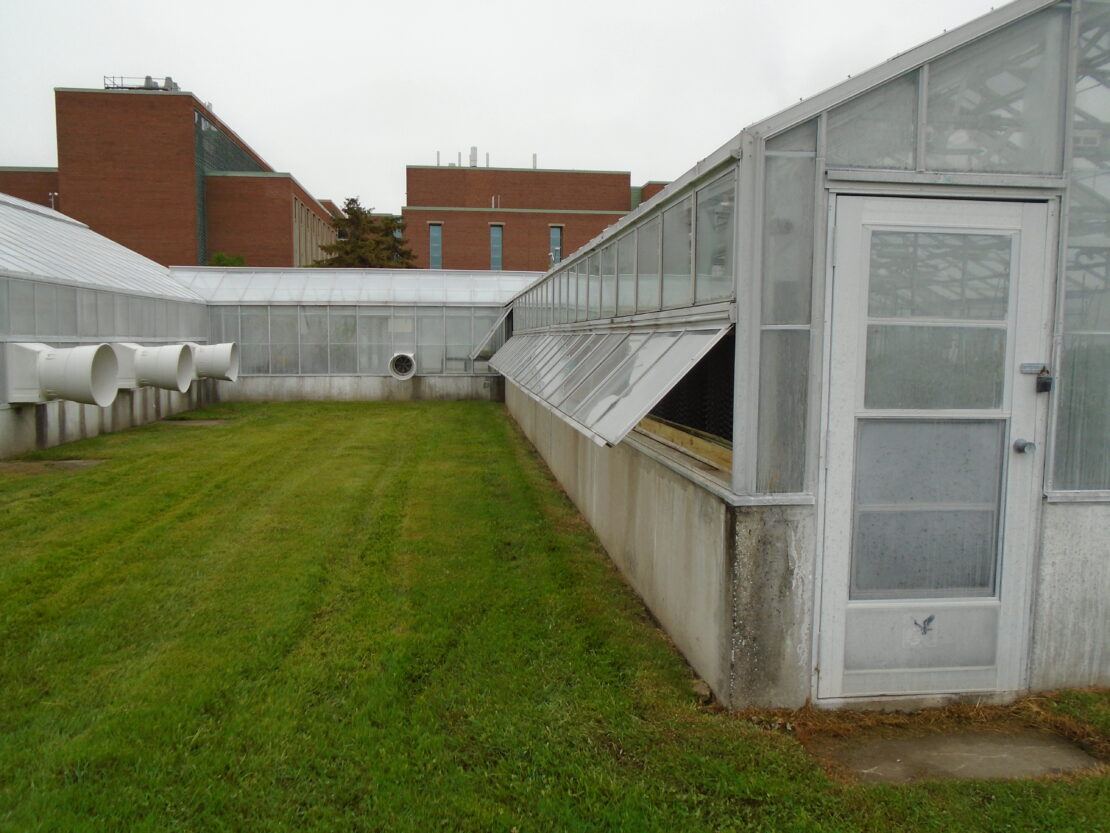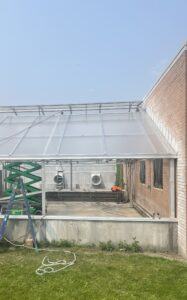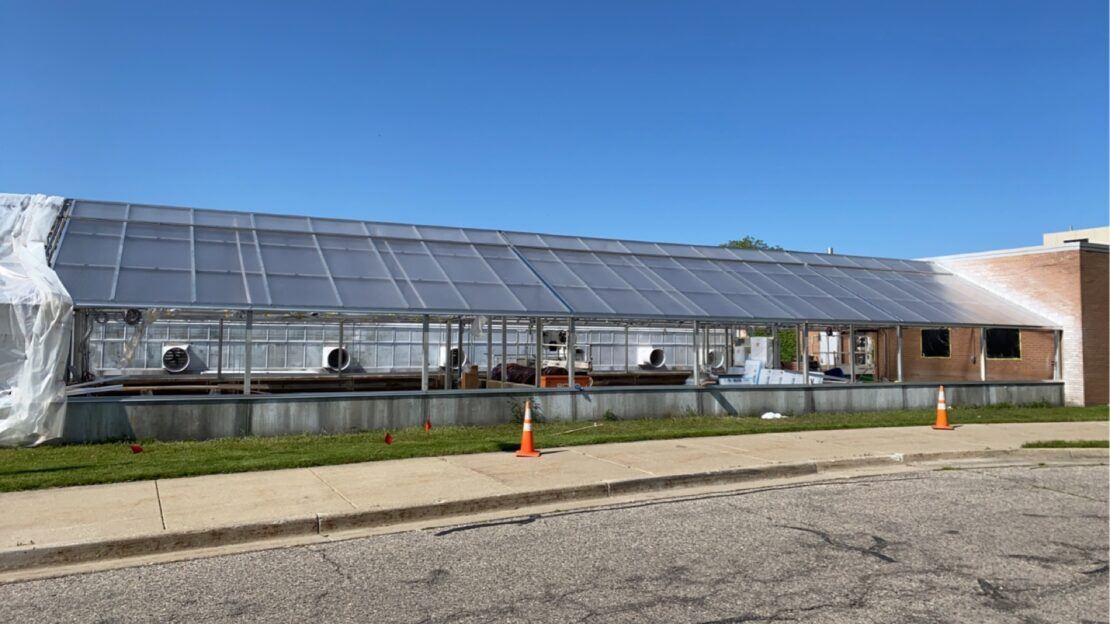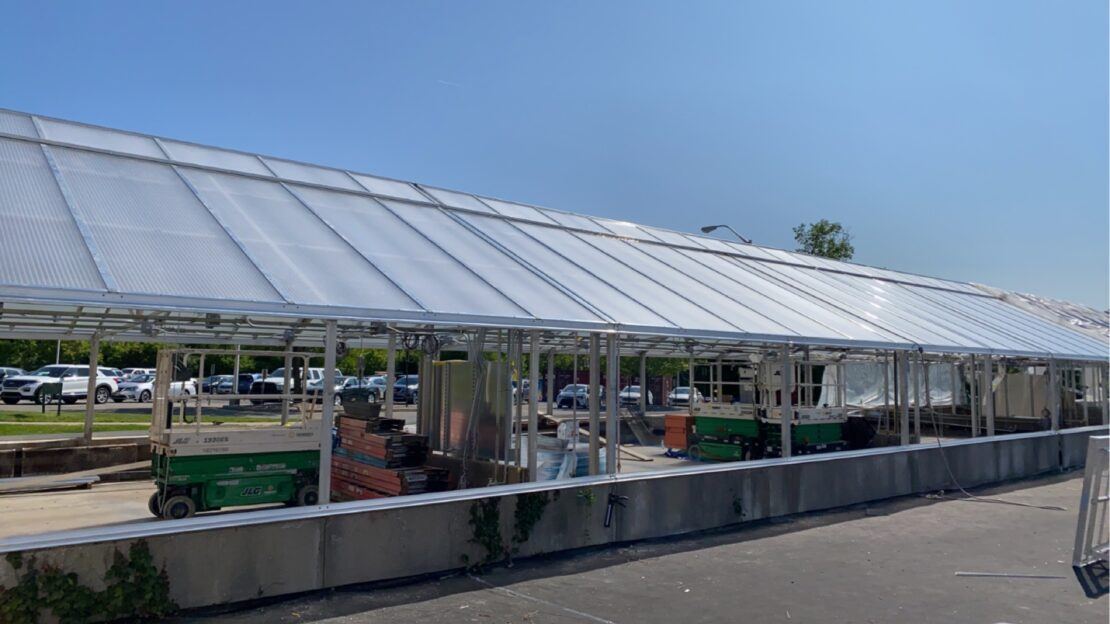Project Details
Project Type
Location
East Lansing, Michigan
Products
Renovation, Repair and Maintenance; Reglazing, Climate Control

With a strong global reputation, Michigan State University (MSU) stands at the forefront of agricultural research and education, thanks to its exceptional plant scientists. These experts play a pivotal role in addressing pressing challenges confronting humanity, such as increasing food production to feed a growing world population and mitigating the impacts of climate change. Plant scientists require precise tools and optimal research conditions to further their work and drive progress. MSU’s Greenhouse Expansion and Restoration project is a perfect example of its commitment to furthering the research work of its plant scientists. Prospiant is proud to be a part of the project with our recent work to update MSU’s greenhouse climate control systems and reglaze some of the outdated greenhouses.
Greenhouse Complex at the Center of Agricultural Research
The MSU greenhouse complex includes around 90,000 square feet of greenhouses, two-thirds of which were built between 1955 and 1978. It serves more than 60 faculty researchers, nearly 400 students, and research staff from eight departments across MSU.
“In the entire greenhouse complex, we have representatives from all Michigan’s crop commodities, from row crops and floriculture to specialty crops,” says Chrislyn Particka, Director of the Plant Science Research Greenhouse Facility at MSU. “We have a huge diversity of plant material and a broad range of needs in terms of growing environments within the greenhouses.”
The outdated state of the greenhouse infrastructure and its limited capacity had reached a point where it would soon hold the university back from furthering its research work and meeting the evolving needs of MSU’s researchers and the Michigan agricultural community. Consequently, the structures required updates to improve energy efficiency, and provide more precise greenhouse climate control.

Greenhouse Climate Control for the Present and Future
One of Particka’s priorities for the renovation was to update the climate control systems in the greenhouses. While many of the greenhouses had some form of environmental controls, they were difficult and time-consuming to use and could not be monitored or accessed remotely.
“We didn’t even have a bare-bones greenhouse climate control system in some houses,” Particka says. “Several of the greenhouses had thermostats, making it very challenging to balance the temperature in any greenhouse, but even more so for a research greenhouse that needs precise control. We had no data-logging capability or anything close to it.”
MSU contracted with Prospiant as the general contractor for the project to install environmental control systems. Installation of environmental control systems is just one of the many services Prospiant offers that range from designing/engineering and general contracting for construction to systems integration and more. The team had to manage the MSU project timeline carefully to ensure it finished all the work by fall when many researchers would return from doing fieldwork. It was also essential that the new control systems integrate with older, existing equipment as well as equipment that would be installed later during a different phase of the renovation.
Prospiant recommended MSU go with Wadsworth Control’s Seed controller, a touchscreen climate controller with a graphic interface that provides extensive information at a glance. The controller would allow for advanced humidity control, real-time data, and remote monitoring and access. Prospiant partnered with High Tech Electrical to do the electrical installation for the project. Overall, the teams worked on six greenhouses at the same time.
Teamwork Prevails Over Unexpected Challenges
One or two weeks into the electrical work, an MSU inspector found that all the old electrical needed to be replaced to meet current building code requirements. Despite this was an unwelcome development, Prospiant remained committed to keeping things moving forward for the university.
“Retrofits can be tricky and a little scary sometimes because we don’t know what is going on behind the walls until we pull them down. Surprises can quickly derail a project,” says Brenna Stencel, Institutional Restoration Manager at Prospiant. “We felt we had a good partnership with the electrician and MSU. Everyone was onboard with keeping the project headed in the right direction.”
Once the greenhouse climate control installation was complete, Wadsworth’s field personnel conducted several programming sessions to ensure everything was dialed in properly according to the researcher’s specifications. The difference this made was immediate.
“We have much better control over the temperatures in the houses,” Particka says. “I can pull up the software at my desk and immediately check temperature levels or see if the equipment is working properly. I have a lot more information to work with, which makes it easier to troubleshoot things.”

Phase Two Reglazing Underway
Prospiant has started another phase of the greenhouse project with anticipated completion in the fall of 2023. Presently, two construction crews are replacing old glass with a diffused-acrylic glazing system, and installing new fans, pad systems, vents, motors, and more on the same greenhouses that received Seed systems last summer. A third crew will join the project soon. With multiple crews working on the project, one concern was having all the materials ready for the crews to start in May. Prospiant is one of the leading North American manufacturers of greenhouses. The team members at its manufacturing division worked hard to restructure production schedules to ensure materials arrived on time.

“A lot of design work and legwork on the admin side has gone into this project,” says Terrell Jones, Project Manager-Commercial Growing at Prospiant. “We are coordinating with different trades that we haven’t worked with before, which requires some strong project management skills to keep everything running smoothly. It has been great to test out our capabilities to be the general contractor for the installation of the climate control systems and the reglazing. We’ve been able to create a direct relationship with MSU where they know they can trust us to give them exactly what they need to do their research work.”
Learn more about Prospiant’s building, restoration, and maintenance services for research and education greenhouse facilities, and check out the restoration of a tropical greenhouse that Prospiant did for the University of California (UC) Berkeley Botanical Gardens.